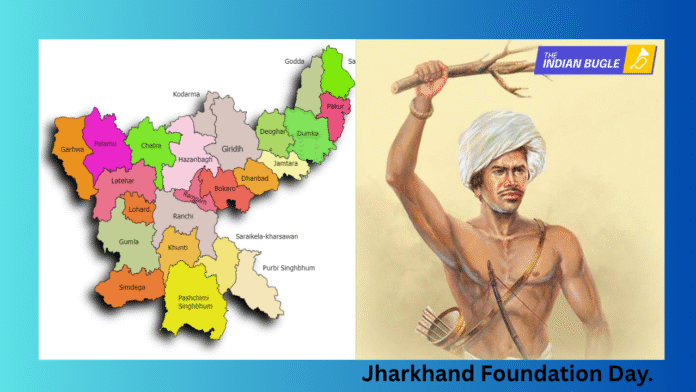Every year on November 15, the people of Jharkhand come together to celebrate Jharkhand Sthapna Diwas, or Jharkhand Foundation Day. This day marks the birth of India’s 28th state in the year 2000, when Jharkhand was officially carved out of Bihar. Interestingly, the date also coincides with the birth anniversary of Birsa Munda, the legendary tribal freedom fighter and folk hero — symbolizing the spirit of resistance, pride, and self-determination of Jharkhand’s indigenous people.
How Jharkhand Was Formed
The creation of Jharkhand was not an overnight decision but the outcome of a century-long struggle. The demand for a separate state arose due to the region’s unique tribal identity, cultural heritage, and geographical characteristics, which distinguished it from Bihar.
After years of political activism, protests, and public movements, the Bihar Reorganisation Act, 2000, was passed by the Indian Parliament. On 15 November 2000, Jharkhand officially came into existence with Ranchi as its capital. Alongside, the state got its own High Court and administrative machinery — marking a new chapter of self-governance and hope.
The Vision Behind Jharkhand’s Formation
The formation of Jharkhand was driven by a strong vision to restore dignity, equity, and opportunity for its people. The key objectives included:
- Empowerment of Indigenous Communities – To protect tribal traditions, culture, and land rights, and to honor the legacy of freedom fighters like Birsa Munda, who fought for Adivasi autonomy.
- Resource Ownership & Fair Development – To ensure the vast mineral and forest wealth of the state benefits the local population, rather than outsiders or large corporations alone.
- Balanced and Inclusive Growth – To bridge the developmental gap between rural tribal belts and industrial hubs like Jamshedpur, Bokaro, and Dhanbad.
- Decentralized Governance – To bring administration closer to people and ensure policies reflect the needs of local communities.
The People Behind the Jharkhand Movement
The creation of Jharkhand owes much to the vision, persistence, and leadership of several stalwarts who dedicated their lives to the statehood cause:
- Jaipal Singh Munda – A charismatic leader, Oxford graduate, and the captain of India’s first Olympic gold-winning hockey team. He was the founder of the Jharkhand Party and one of the earliest champions of a separate Jharkhand state in independent India.
- Shibu Soren – Popularly known as Dishom Guru, he led the Jharkhand Mukti Morcha (JMM) and played a pivotal role in uniting tribal and non-tribal communities under one banner.
- Binod Bihari Mahato and A.K. Roy – Social reformers and co-founders of the JMM, they mobilized industrial and mining workers in the movement for economic and social justice.
- Kartik Oraon, N.E. Horo, and others – Contributed through political advocacy, cultural awakening, and grassroots movements to keep the statehood dream alive.
These leaders envisioned Jharkhand as a land where its people could thrive with dignity, identity, and opportunity.
Importance of Jharkhand on the World Stage
Despite being a young state, Jharkhand holds immense strategic and economic significance — not only for India but also globally.
- Mineral Powerhouse – Jharkhand is among India’s richest mineral-bearing regions, holding a large share of the country’s coal, iron ore, copper, mica, and uranium reserves. It plays a crucial role in India’s energy, steel, and industrial sectors.
- Steel & Manufacturing Hub – Home to Tata Steel’s Jamshedpur, India’s first planned industrial city, and Bokaro Steel Plant, one of Asia’s largest, Jharkhand remains a backbone of the country’s manufacturing and infrastructure development.
- Nuclear and Energy Contribution – The Jaduguda Uranium Mine, located in the state, has been vital in supporting India’s nuclear energy program.
- Cultural and Sports Influence – The state has produced global sports icons like Deepika Kumari, a former world number one in archery, and several hockey players who represent India on international platforms. Its traditional dances, festivals, and art forms like Chhau and Sohrai have also gained worldwide recognition.
How Jharkhand Sthapna Diwas Is Celebrated
Jharkhand Foundation Day is celebrated with immense enthusiasm across the state, blending official ceremonies with vibrant cultural festivities.
1. State-Level Celebrations
The main event takes place at Morabadi Ground in Ranchi, where the Chief Minister and other dignitaries launch new schemes, felicitate achievers, and showcase development projects. Folk performances, parades, and exhibitions are organized to reflect the state’s progress and cultural diversity.
2. Cultural Programs
Throughout the week, local artists perform traditional tribal dances like Chhau, Paika, and Karma, while exhibitions display tribal art, crafts, and cuisine. Various cultural institutions and NGOs hold Jharkhand Mahotsavs to celebrate the rich Adivasi heritage.
3. Schools and Colleges
Educational institutions host debates, quizzes, essay competitions, and cultural events to raise awareness among children about Jharkhand’s history and achievements. Students also participate in processions and exhibitions showcasing the state’s culture.
4. Community and Diaspora Events
Outside Jharkhand too, communities and organizations observe Jharkhand Sthapna Diwas with pride. They organize cultural gatherings, folk performances, and discussions on the state’s development journey.
5. Digital and Media Celebrations
Social media platforms come alive with posts, artwork, poems, and songs celebrating the state’s natural beauty, tribal pride, and progress. The day is also celebrated nationally as “Janjatiya Gaurav Divas”, honoring Birsa Munda’s unmatched contribution to India’s tribal heritage.
Conclusion
Jharkhand Sthapna Diwas is more than just a celebration of a state’s birth — it is a tribute to resilience, unity, and the unyielding spirit of its people. From the dense forests of Saranda to the bustling steel city of Jamshedpur, Jharkhand reflects the perfect blend of tradition and progress.
As the state continues to grow as an industrial, cultural, and ecological powerhouse, the vision of its founding leaders — a Jharkhand of justice, identity, and opportunity — remains more relevant than ever.
